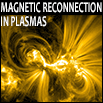Speaker
Prof.
Nagendra Singh
(University of Alabama in Huntsville)
Description
We study the evolution of an electron current layer (ECL)
through its several
stages by means of three-dimensional particle-in-cell (PIC)
simulations with ion
to electron mass ratio M/me =400. An ECL evolves through
the following stages:
(i) Electrostatic (ES) current-driven instability (CDI) soon
after its formation with
half width w about 2 electron skin depth (de), (ii) current
disruption in the
central part of the ECL by trapping of electrons and
generation of anomalous
resistivity, (iii) electron tearing instability (ETI) with
significantly large growth
rates in the lower end of the whistler frequency range, (iv)
widening of the ECL
and modulation of its width by the ETI, (v) gradual heating of
electrons by the
CDI-driven ES ion modes create the condition that the
electrons become hotter
than the ions, (vi) despite the reduced electron drift
associated with the current
disruption by the CDI, the enhanced electron temperature
continues to favor a
slow growth of the ion waves reaching nonlinear amplitudes,
(vii) the nonlinear
ion waves under go modulation and collapse into localized
density cavities
containing spiky electric fields like in double layers (DLs),
(viii) such spiky electric
fields are very effective in further rapid heating of both
electrons and ions. As
predicted by the electron magnetohydrodynamic (EMHD)
theories, the ETI
growth rate maximizes at wave numbers in the range 0.4<
kxW < 0.8 where kx
is the wave number parallel to the ECL magnetic field and w
is the evolving half
width of the ECL. The developing ETI generates in-plane
currents that support
out-of-plane magnetic fields around the emerging x-lines. The
ETI and the spiky
electrostatic structures are accompanied by fluctuations in
the magnetic fields
near and above the lower-hybrid (ion plasma) frequency,
including the whistler
frequency range. We compare our results with experimental
results and satellite
observation.
Primary author
Prof.
Nagendra Singh
(University of Alabama in Huntsville)

